Performance Enhancement of Self-Cleaning Hydrophobic Nanocoated Photovoltaic Panels in a Dusty Environment
Abstract
:1. Introduction
1.1. PV-Based Renewable Energy Solutions for Bulk Energy Demand
1.2. PV Panels and the Impact of Dust
1.3. Performance of PV Panels and Their Cleaning Characteristics
1.4. PV Panel Efficiency and Its Maximization
1.5. Contribution of This Paper
1.6. Structure of This Paper
2. Problem Formulation: Performance Management for Coated PV Panels
2.1. State Representation of the Proposed System
2.2. PV Modules and Efficiency
2.3. Improvement Factor of PV Panels—Coated and Uncoated
2.4. Proposed Coated PV Panel and its Performance Ratio
3. Proposed Self-Cleaning Hydrophobic Nanocoated PV Panel—Experimental Setup and Materials
3.1. Nanocoating Materials
3.2. Testing of Coated Samples
3.2.1. First Test
3.2.2. Second Test
3.3. Test Samples Coating Procedure
3.4. Experimental Setup
3.4.1. PV Panels
3.4.2. Micro-Inverter
3.4.3. ABB Data Logger
3.4.4. Plant Viewer
3.4.5. Weather Station
3.4.6. Other Materials
4. Results and Evaluation
4.1. Experimental Procedures
4.1.1. Coating Process Optimization
4.1.2. Measurement of Contact Angle
4.1.3. Coating of PV Module
4.1.4. PV Module Cleaning Process
4.2. Parameter Performance
4.2.1. Hourly Daily Power for Coated and Uncoated Modules
4.2.2. Power Efficiency for Coated and Uncoated Panels
4.2.3. Average Electrical Efficiency of the Coated Module
4.2.4. Daily Generated Energy between Two Cleaning Cycles
5. Conclusions
Author Contributions
Funding
Conflicts of Interest
Nomenclature
| Acronyms | |
| AUS | Australia |
| CDD | Concentrator Data Device |
| DI | Deionized |
| EUR | Europe |
| HU | Hashemite University |
| MEAST | Middle East |
| MENA | Middle East and North Africa |
| MPPT | Maximum Power Point Tracking |
| MW | Mega Watt |
| NAFR | North Africa |
| NAME | North America |
| NEAsia | Northeast Asia |
| PC | Personal Computer |
| PR | Performance Ratio |
| PV | Photovoltaic |
| SAME | South America |
| SWAsia | Southwest Asia |
| UN | United Nations |
| UV-V | Ultraviolet–Visible |
| Symbols | |
| Na+ | Sodium ion |
| Ca+ | Calcium ion |
| K+ | Potassium ion |
| Mg+2 | Magnesium ion |
| Ca+2 | Calcium ion |
| O2 | Oxygen |
| Si | Silicon |
| SiO2 | Silicon Dioxide |
| Fe | Iron |
| (-Si(CH3)2O-] n) | Silicone oil |
| R4 (OR5) p—OH | Polysiloxane resin |
| (CH3)2CHOH) | Isopropyl alcohol |
| fused form of temperature state | |
| subspace | |
| c | coated panel |
| uc | uncoated panel |
| F | model matrix of temperature state |
| transition matrix of coated PV module temperature | |
| transition matrix of coated PV module temperature | |
| heat absorbed by the PV solar | |
| coefficient for heat absorption | |
| A | area of PV module |
| R | reflectivity |
| I | intensity of solar radiation |
| absorption coefficient | |
| temperature function | |
| depth of penetration of solar light | |
| efficiency | |
| output module power | |
| incident solar radiation | |
| improvement factor | |
| output module energy | |
References
- Ali, M.; Alireza, R.; Behrooz, M.Z.; Farzad, S.; Lasse, R. Hybrid energy harvesting system to maximize power generation from solar energy. Energy Convers. Manag. 2020, 205, 112352. [Google Scholar]
- Laveet, K.; Hasanuzzamana, M.; Rahim, N.A. Global advancement of solar thermal energy technologies for industrial process heat and its future prospects: A review. Energy Convers. Manag. 2019, 195, 885–908. [Google Scholar]
- Montaser, M.; Mohamad, R.; Abdul-Ghani, O.; Keith, P.; Sumsun, N. A review of mechanical energy storage systems combined with wind and solar applications. Energy Convers. Manag. 2020, 210, 112670. [Google Scholar]
- Solar Energy Ranks as the Top Renewable Energy Source in the World. The NYU Dispatch, 23 April 2018. Available online: https://wp.nyu.edu/dispatch/2018/04/23/solar-energy-ranks-as-the-top-renewable-energy-source-in-the-world/ (accessed on 23 April 2018).
- Gholami, A.; Khazaee, I.; Eslami, S.; Zandi, M.; Akrami, E. Experimental investigation of dust deposition effects on photo-voltaic output performance. Sol. Energy 2018, 159, 346–352. [Google Scholar] [CrossRef]
- Al-Badra, M.Z.; Abd-Elhady, M.S.; Kandil, H.A. A novel technique for cleaning PV panels using antistatic coating with a mechanical vibrator. Energy Rep. 2020, 6, 1633–1637. [Google Scholar] [CrossRef]
- Zhong, H.; Hua, Y.; Wang, Y.; Yang, H. TiO2/silane coupling agent composed of two layers structure: A super-hydrophilic self-cleaning coating applied in PV panels. Energy Procedia 2017, 105, 1077–1083. [Google Scholar] [CrossRef]
- Abd-Elhady, M.S.; Fouad, M.M.; Khalil, T. Improving the efficiency of photovoltaic (PV) panels by oil coating. Energy Convers. Manag. 2016, 115, 1–7. [Google Scholar] [CrossRef]
- Sun, K.; Jiang, L.; Lu, Y.; Wang, Y.; Zhou, K.; He, Z. Integrated effects of PM2.5 deposition, module surface conditions and nano-coatings on solar PV surface glass transmittance. Renew. Sustain. Energy Rev. 2018, 82 Pt 3, 4107–4120. [Google Scholar] [CrossRef]
- Maghami, M.R.; Hizam, H.; Gomes, C.; Radzi, M.A.; Rezadad, M.I.; Hajighorbani, S. Power loss due to soiling on solar panel: A review. Renew. Sustain. Energy Rev. 2016, 59, 1307–1316. [Google Scholar] [CrossRef] [Green Version]
- Cordero, R.R.; Damiani, A.; Laroze, D.; MacDonell, S.; Jorquera, J.; Sepúlveda, E.; Feron, S.; Llanillo, P.; Labbe, F.; Carrasco, J.; et al. Effects of soiling on photovoltaic (PV) modules in the Atacama Desert. Sci. Rep. 2018, 8, 1–14. [Google Scholar] [CrossRef] [Green Version]
- Caron, J.R.; Littmann, B. Direct monitoring of energy lost due to soiling on first solar modules in California. IEEE J. Photovolt. 2013, 3, 336–340. [Google Scholar] [CrossRef]
- Ghazi, S.; Sayigh, A. Dust effect on flat surfaces—A review paper. Renew. Sustain. Energy Rev. 2014, 33, 742–751. [Google Scholar] [CrossRef]
- Shao, Y.; Klose, M.; Wyrwoll, K.H. Recent global dust trend and connections to climate forcing. J. Geophys. Res. Atmos. 2013, 118, 1–11. [Google Scholar] [CrossRef]
- Deutsche Gesellschaft für Sonnenenergie (DGS). Planning and Installing Photovoltaic Systems: A Guide for Installers, Architects and Engineers; Routledge: London, UK, 2008; pp. 1–521. [Google Scholar]
- Mekhilef, S.; Saidur, R.; Kamalisarvestani, M. Effect of dust, humidity, and air velocity on efficiency of photovoltaic cells. Renew. Sustain. Energy Rev. 2012, 16, 2920–2925. [Google Scholar] [CrossRef]
- Costa, S.C.S.; Diniz, A.S.A.C.; Kazmerski, L.L. Dust and soiling issues and impacts relating to solar energy systems: Literature review update for 2012–2015. Renew. Sustain. Energy Rev. 2016, 63, 33–61. [Google Scholar] [CrossRef] [Green Version]
- Costa, S.C.S.; Diniz, A.S.A.C.; Kazmerski, L.L. Solar energy dust and soiling R&D progress: Literature review update for 2016. Renew. Sustain. Energy Rev. 2018, 82, 2504–2536. [Google Scholar]
- Zeedan, A.; Barakeh, A.; Al-Fakhroo, K.; Touati, F.; Gonzales, A.S.P., Jr. Quantification of PV Power and Economic Losses Due to Soiling in Qatar. Sustainability 2021, 13, 3364. [Google Scholar] [CrossRef]
- Shaju, A.; Chacko, R. Soiling of photovoltaic modules—Review. In Proceedings of the International Conference on Recent Advancements and Effectual Researches in Engineering Science and Technology (RAEREST), Kerala State, India, 20–21 April 2018; Volume 396, pp. 1–10. [Google Scholar]
- Mehmood, U.; Al-Sulaiman, F.A.; Yilbas, B.S. Characterization of dust collected from PV modules in the area of Dhahran, Kingdom of Saudi Arabia, and its impact on protective transparent covers for photovoltaic applications. Sol. Energy 2017, 141, 203–209. [Google Scholar] [CrossRef]
- Yilbas, B.S.; Ali, H.; Khaled, M.M.; Al-Aqeeli, N.; Abu-Dheir, N.; Varanasi, K.K. Influence of dust and mud on the optical, chemical and mechanical properties of a PV protective glass. Sci. Rep. 2015, 5, 15833. [Google Scholar] [CrossRef]
- Hammad, B.; Al-Abed, M.; Al-Ghandoor, A.; Al-Sardeah, A.; Al-Bashir, A. Modelling and analysis of dust and temperature effects on photovoltaic systems’ performance and optimal cleaning frequency: Jordan case study. Renew. Sustain. Energy Revis. 2018, 82, 2218–2234. [Google Scholar] [CrossRef]
- Hudedmani, M.G.; Joshi, G.; Umayal, R.M.; Revankar, A. A comparative study of dust cleaning methods for the solar PV panels. Adv. J. Grad. Res. 2017, 1, 24–29. [Google Scholar] [CrossRef] [Green Version]
- Burke, M.; Greenough, R.; Jensen, D.; Voss, E. Project SPACE: Solar Panel Automated Cleaning Environment. Bachelor’s Thesis, Santa Clara University, Santa Clara, CA, USA, 2016. [Google Scholar]
- Makableh, Y.F.; Aljaiuossi, G.; Al-Abed, R. Comprehensive design analysis of electron transmission nanostructured layers of heterojunction perovskite solar cells. Superlattices Microstruct. 2019, 130, 390–395. [Google Scholar] [CrossRef]
- Mohammed, H.A.; Al-Hilli, B.A.M.; Al-Mejibli, I.S. Smart system for dust detecting and removing from solar cells. J. Phys. Conf. Ser. 2018, 1032, 1–8. [Google Scholar] [CrossRef]
- Makableh, Y.F.; Vasan, R.; Lee, S.; Manasreh, O.M. Enhancement of the performance of InAs quantum dots solar cell by surface modification using Poly-L-Lysine homopolymers. Appl. Phys. Lett. 2013, 102, 051904. [Google Scholar] [CrossRef]
- Makableh, Y.F.; Nusir, A.I.; Morris, H.; McKenzie, K.; Manasreh, O. Performance enhancement of InAs quantum dots solar cells by using nanostructured anti-reflection coating with hydrophobic properties. J. Nanophotonics 2016, 10, 046018. [Google Scholar] [CrossRef]
- Cully, P.; Karasu, F.; Muller, L.; Jauzein, T.; Leterrier, Y. Self-cleaning and wear-resistant polymer nanocomposite surfaces. Surf. Coat. Technol. 2018, 348, 111–120. [Google Scholar] [CrossRef]
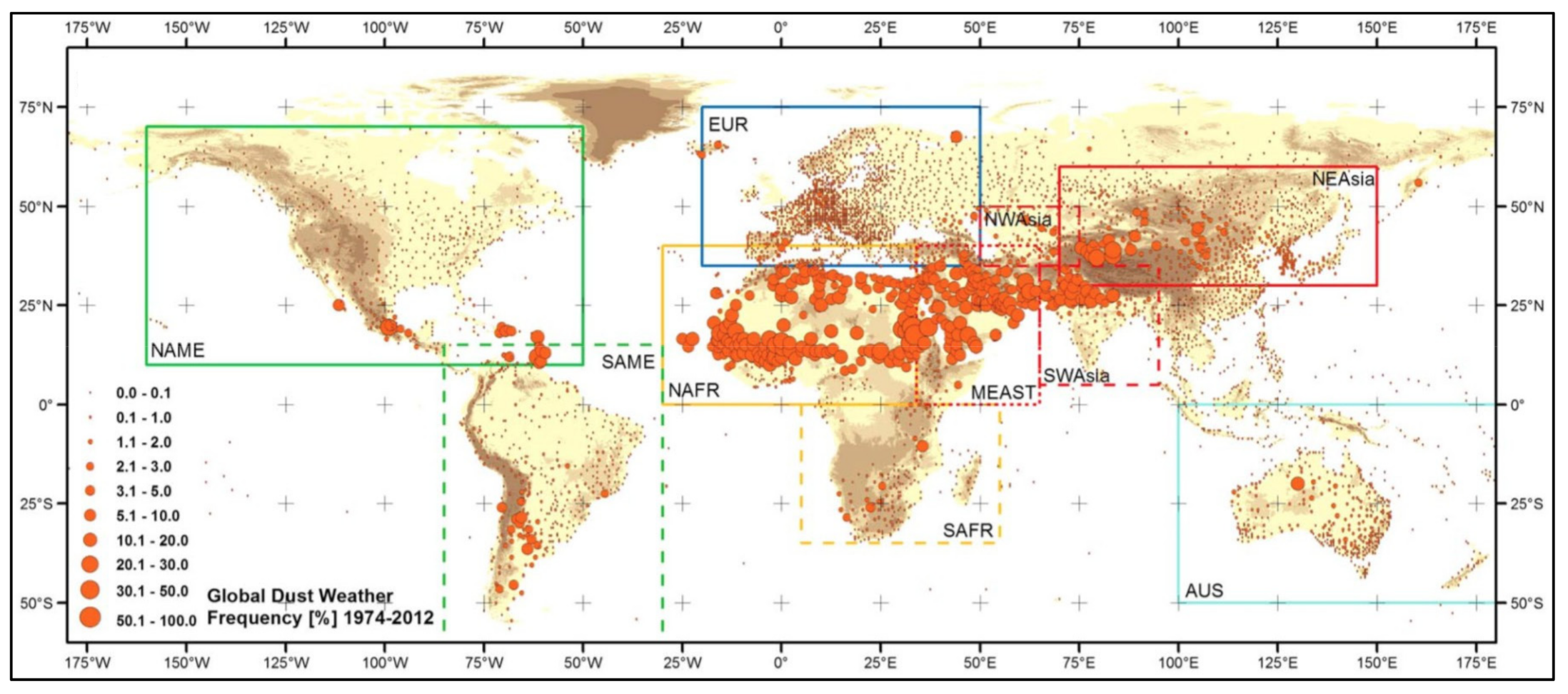
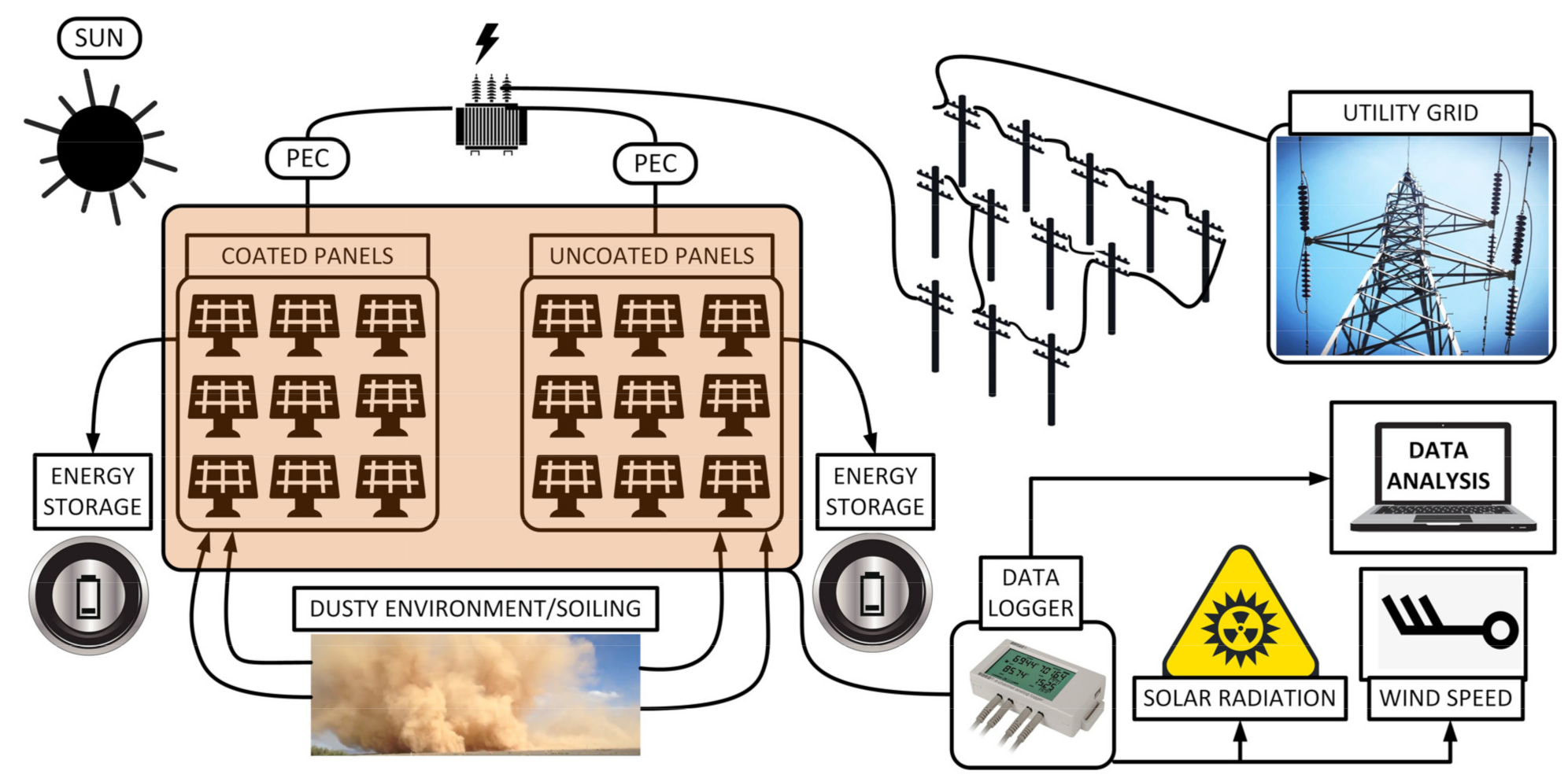
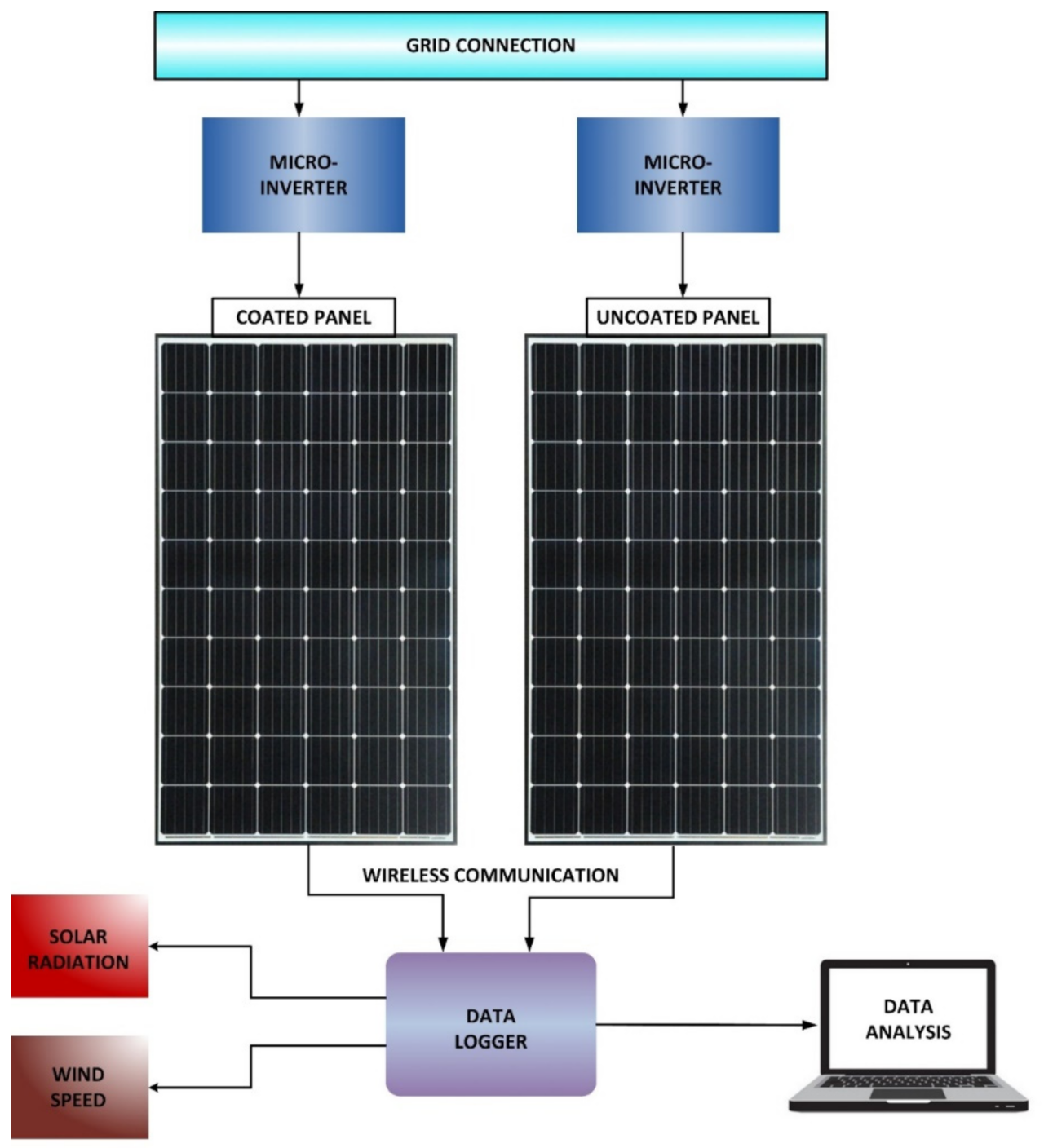



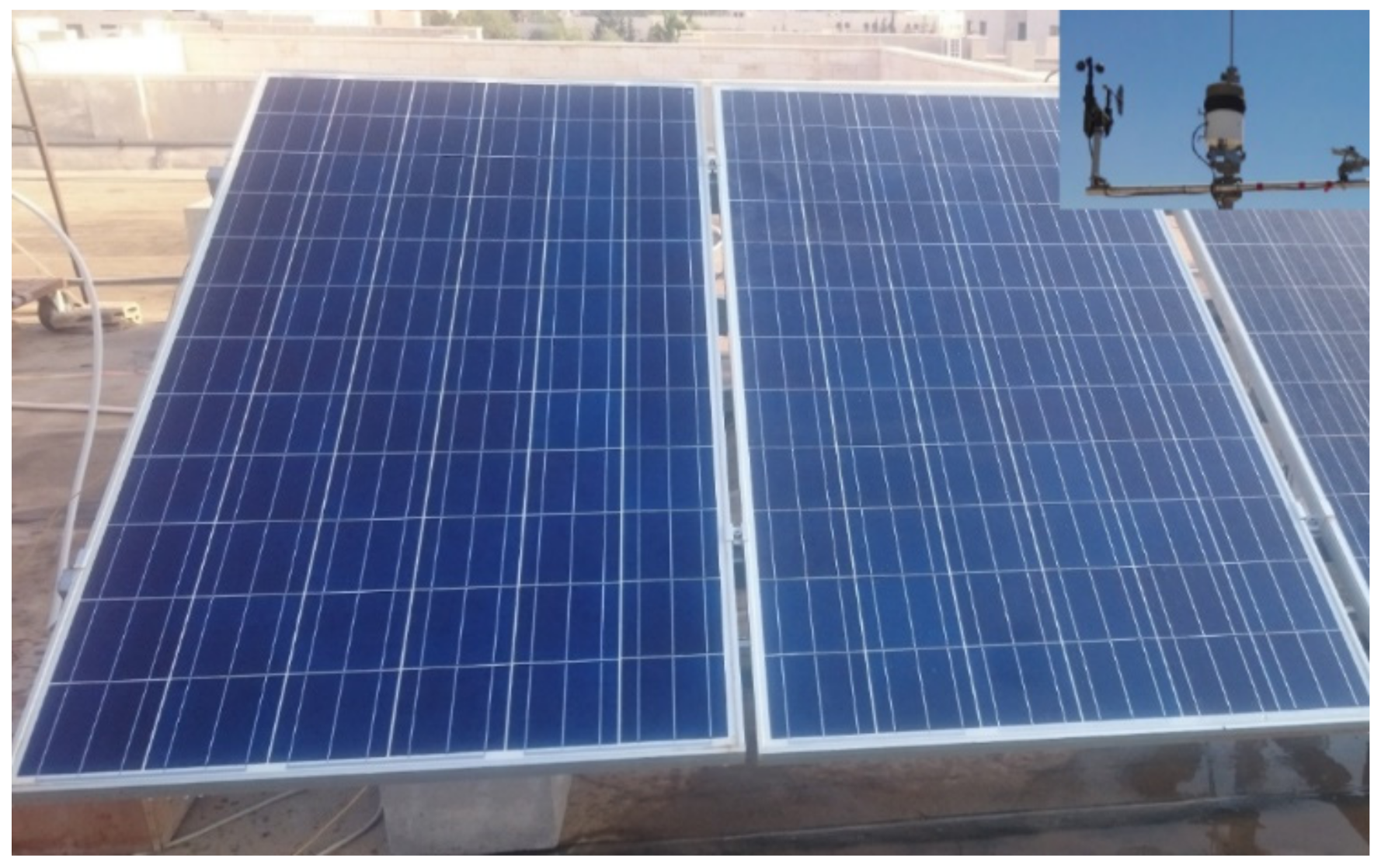
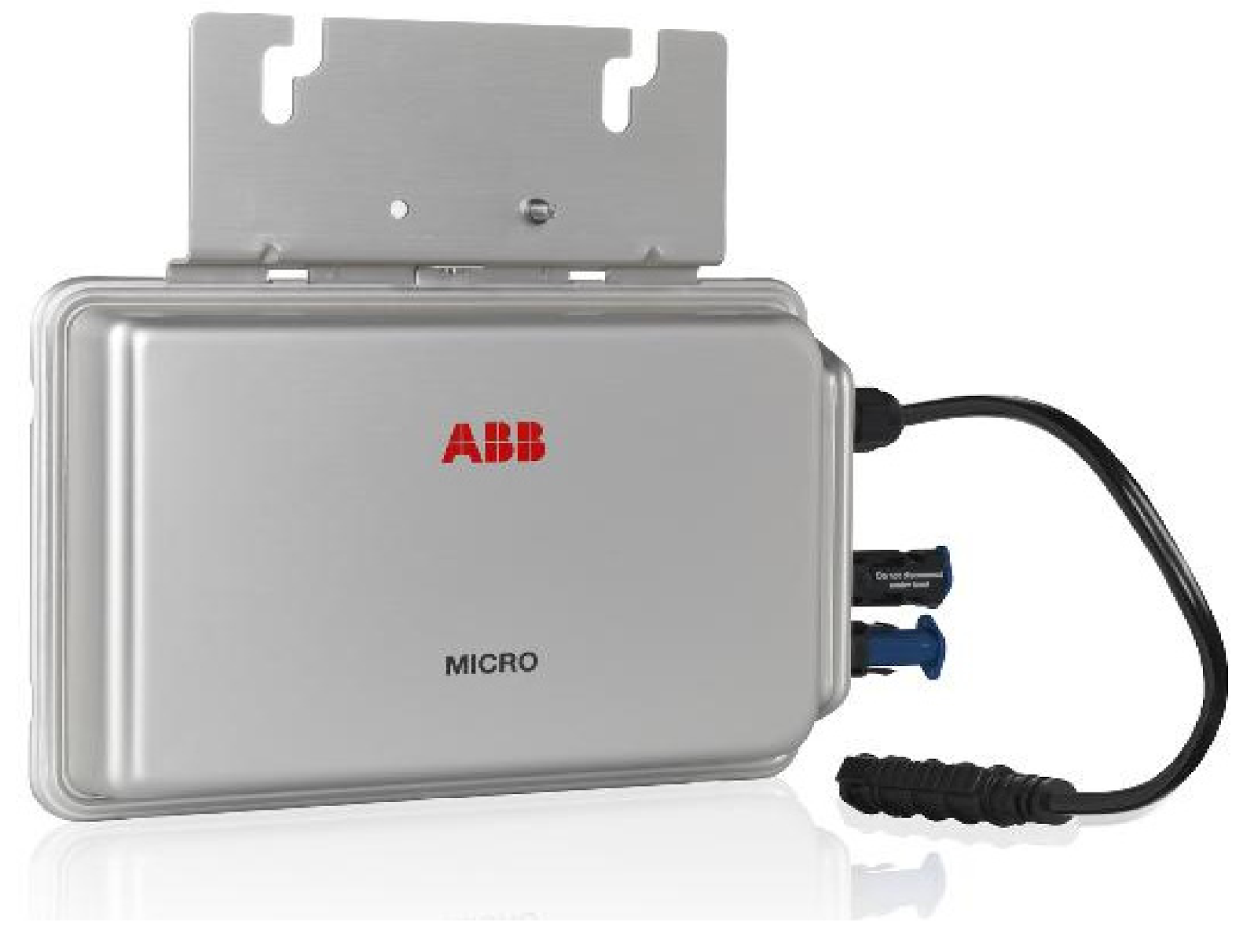
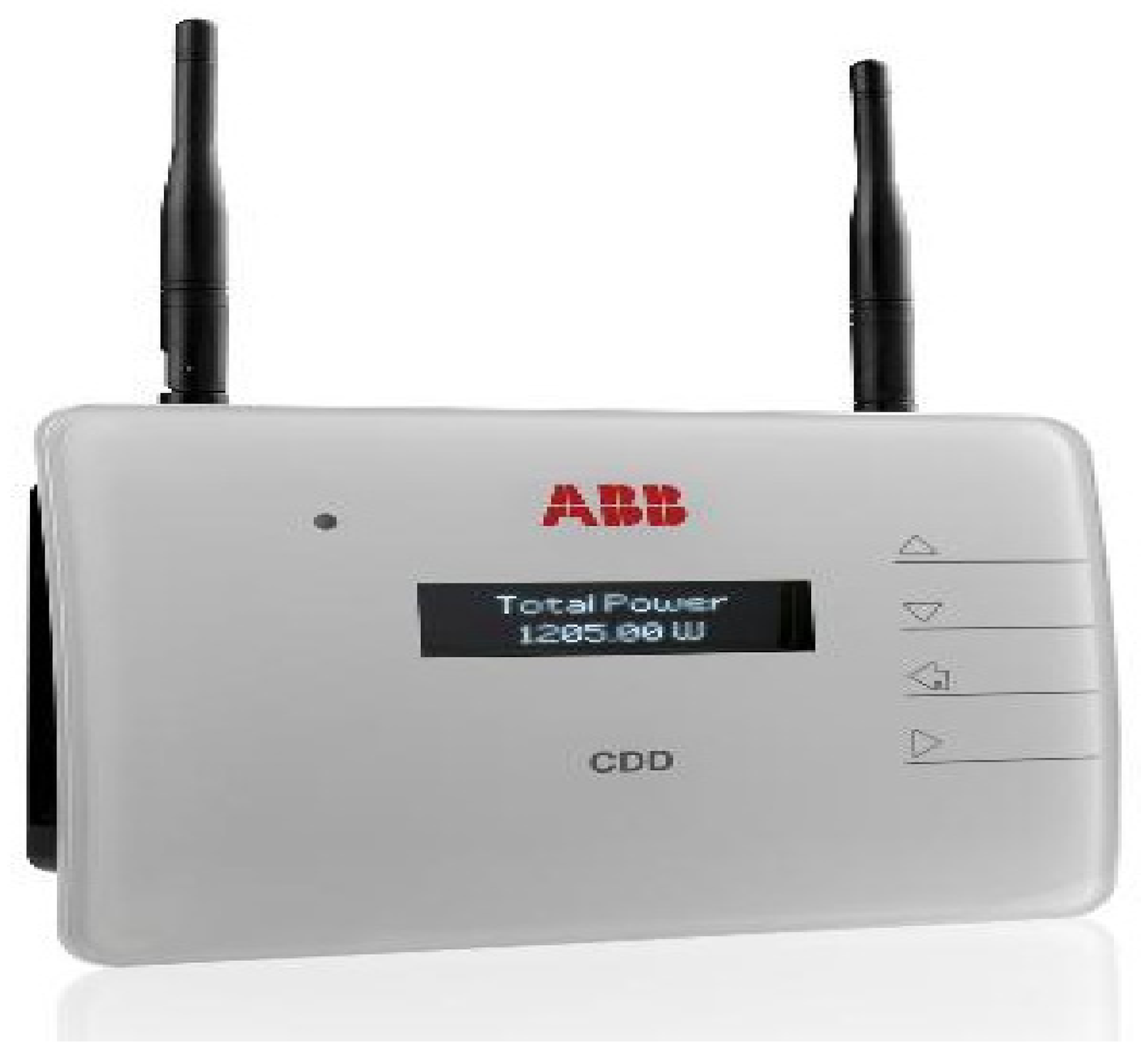
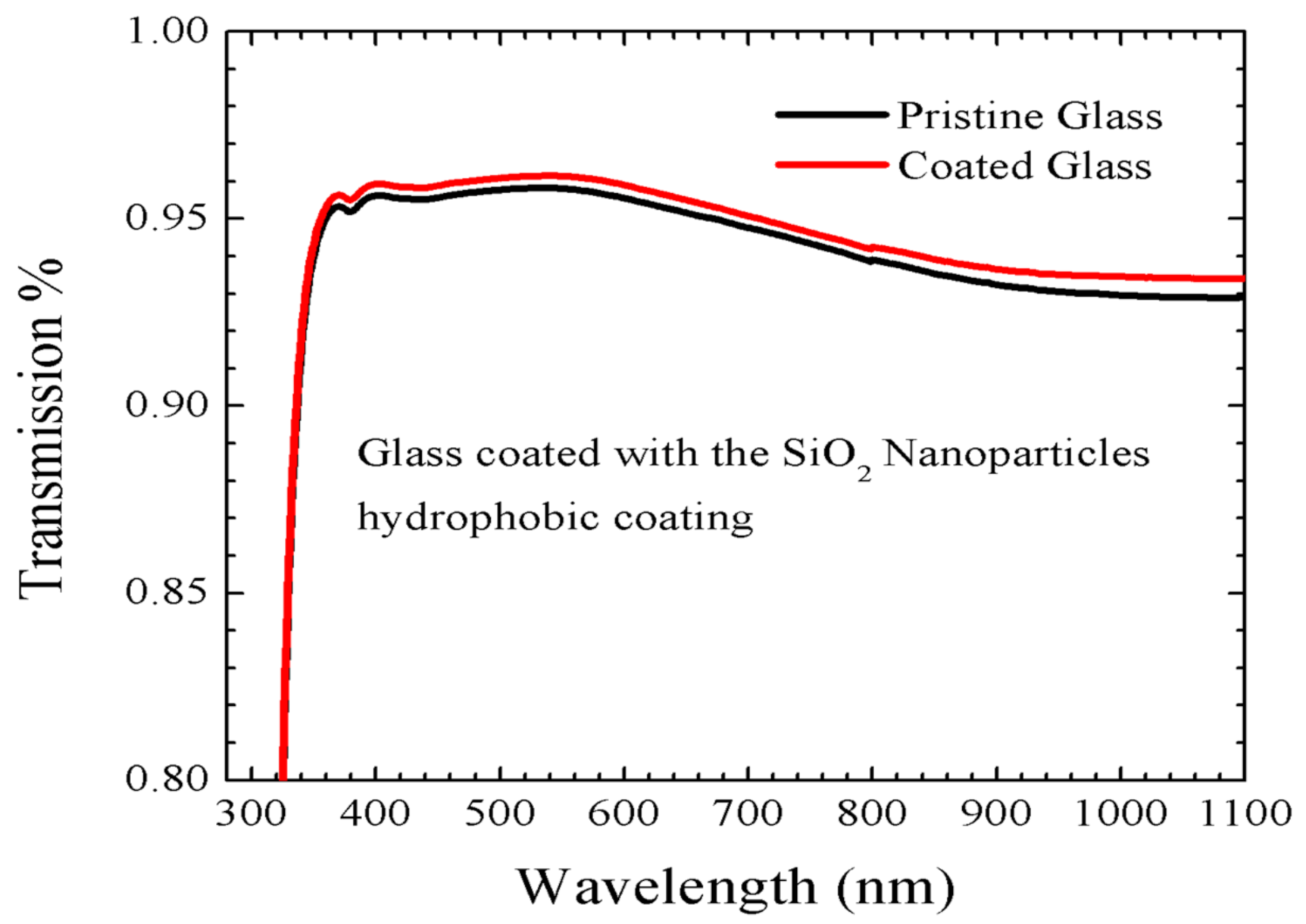

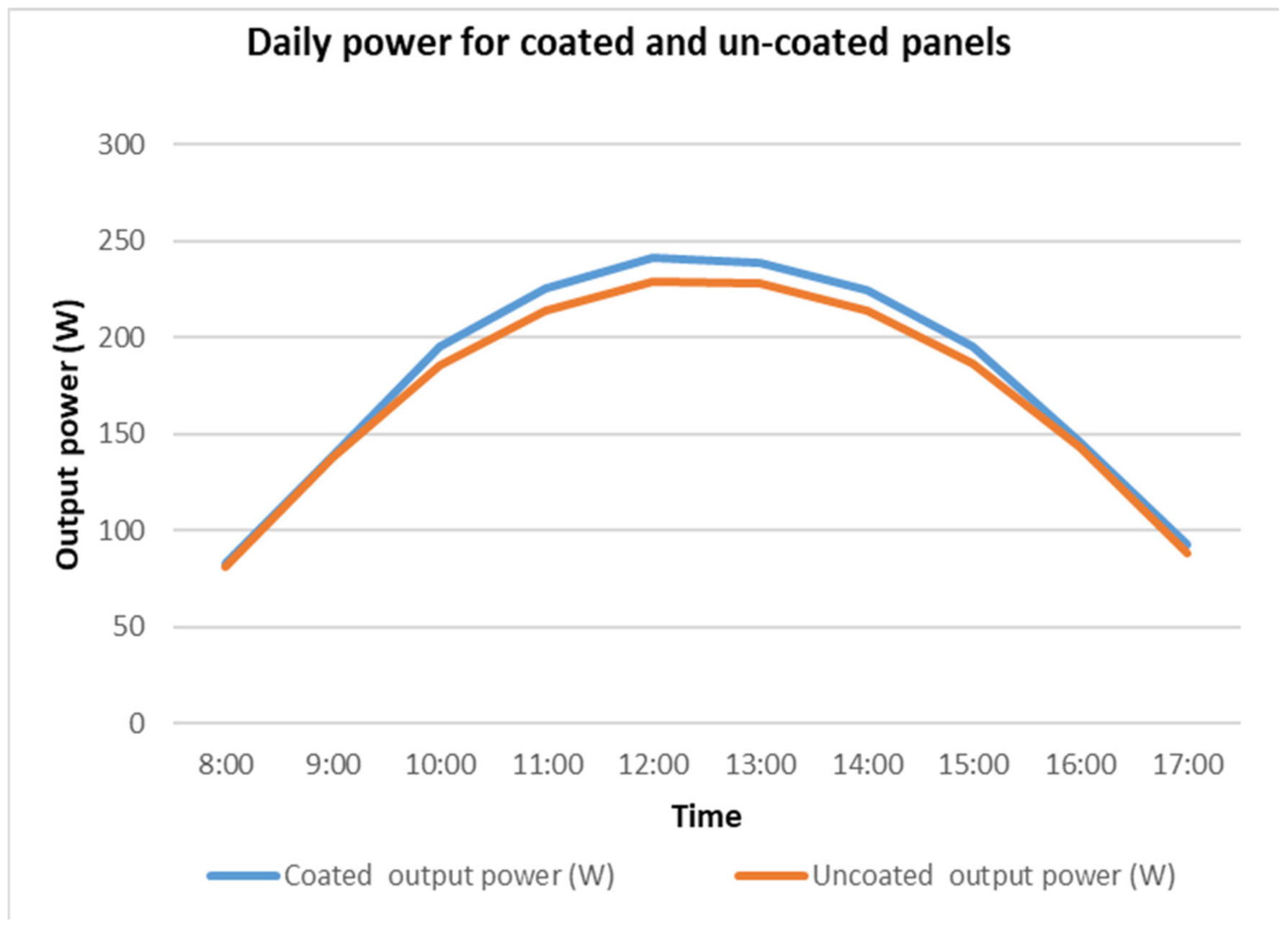
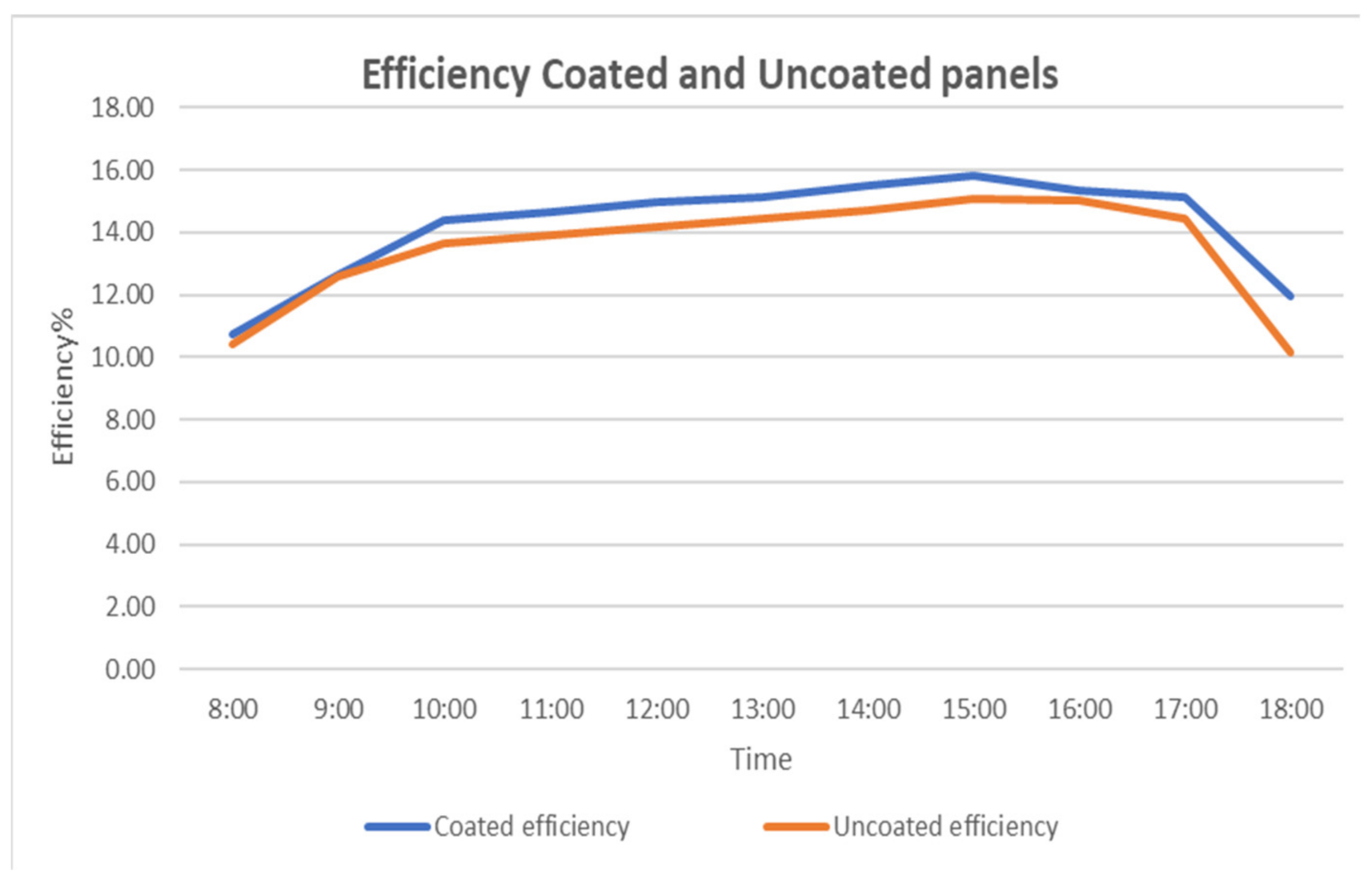
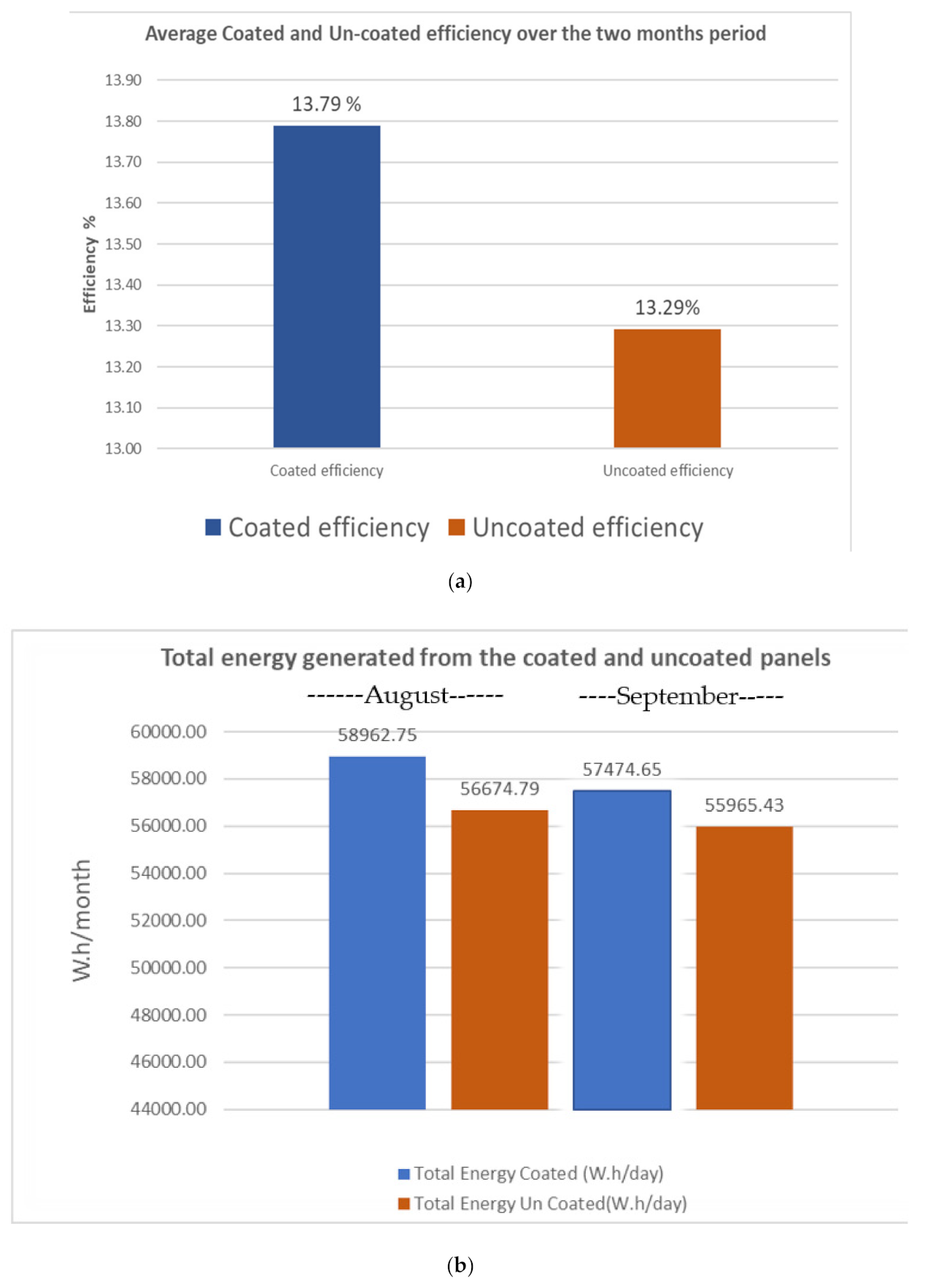
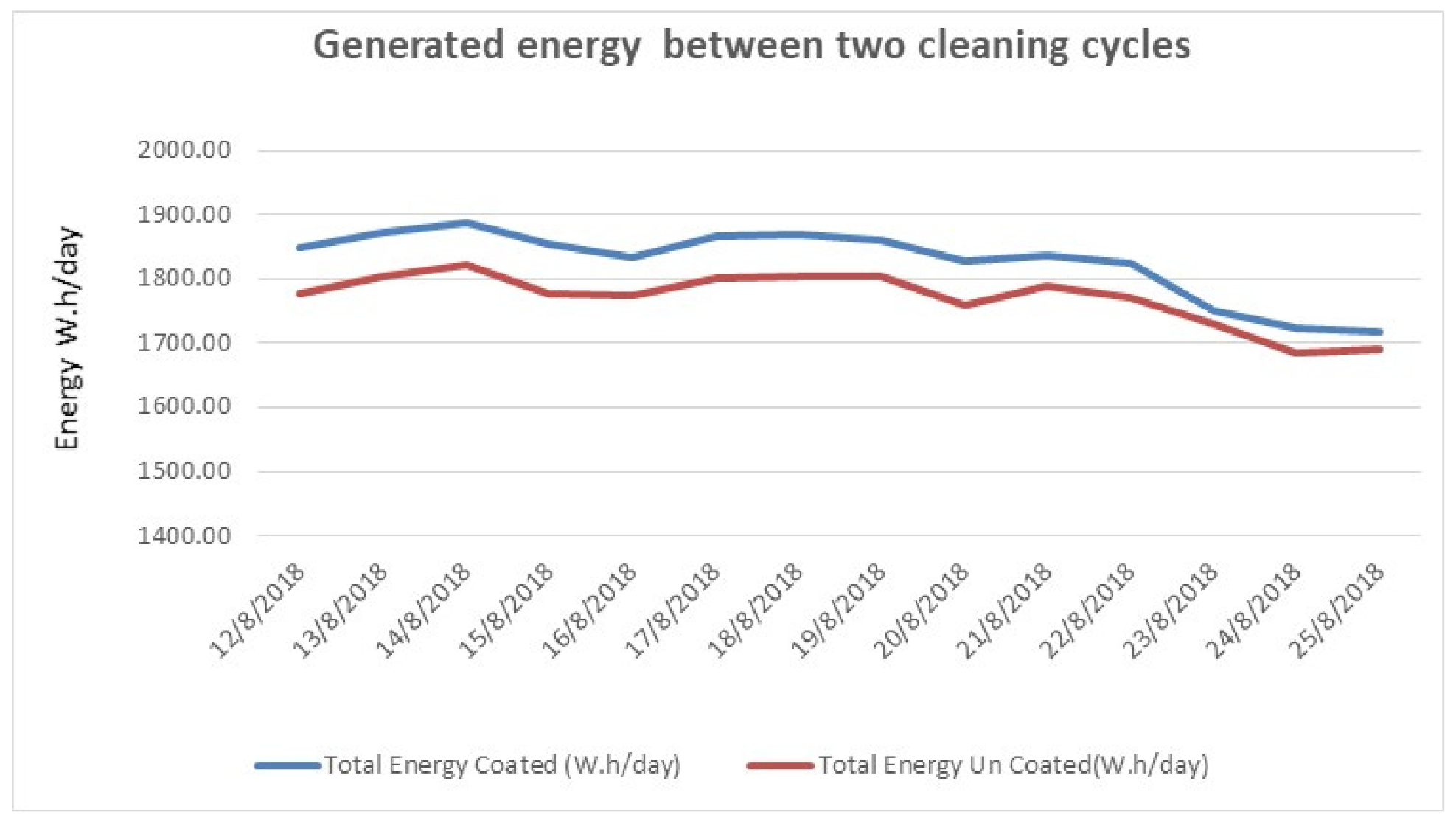
| Contact Angle | First Sample | Second Sample |
|---|---|---|
| Degree of Angle | 104.91 | 104.47 |
| Contact Angle Picture |  | 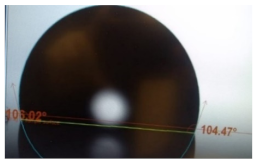 |
| Steps of Coating Procedure | Images of Procedure |
|---|---|
| STEP 1: Two samples were cleaned with water and soap. |  |
| STEP 2: Samples were washed by distilled water. | 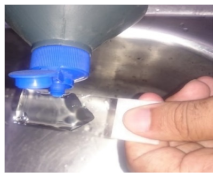 |
| STEP 3: The sample was flooded in organic cleaners (isopropanol) at (US portable cleaner) ultrasound device. This was required to be cleaned from dirt, oil, and grease contamination. | 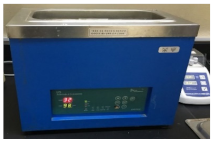 |
| STEP 4: Nanomaterial was added to a sponge. This is then further swabbed on the surface of the sample horizontally and vertically. | 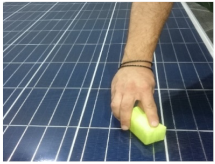 |
| STEP 5: The module was buffed with a towel. | 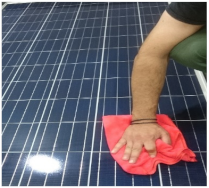 |
| PV Module—Polycrystalline Silicon | Specification |
|---|---|
| Module Efficiency at standard test conditions (STC) | 15.4% |
| Maximum Power Output | 300 W |
| Maximum Power Voltage | 36.7 V |
| Maximum Power Current | 8.17 A |
| Open Circuit Voltage | 46.3 V |
| Short-Circuit Current | 8.77 A |
| Temperature Coefficient | −0.45 °C |
| Module Area | 1970 mm × 990 mm |
| Weight | 25.8 kg |
| ABB MICRO Inverter | Specification |
|---|---|
| Nominal output power | 300 W |
| Maximum DC input power | 310 W |
| Maximum voltage V DC max | 65 V |
| Maximum current I DC max | 10.5 A |
| Maximum short-circuit limit | 12.5 A |
| ABB Data Logger-Radio-IEEE-8.2.15.4 | Specifications |
|---|---|
| Sample rate | 1 min |
| Maximum distance | 50 m |
| Wireless communication | Radio-IEEE 802.15.4/b-2.4 GHz/10 Mbps |
| Wired communication | Ethernet RJ45 Ethernet |
Publisher’s Note: MDPI stays neutral with regard to jurisdictional claims in published maps and institutional affiliations. |
© 2021 by the authors. Licensee MDPI, Basel, Switzerland. This article is an open access article distributed under the terms and conditions of the Creative Commons Attribution (CC BY) license (https://creativecommons.org/licenses/by/4.0/).
Share and Cite
Aljdaeh, E.; Kamwa, I.; Hammad, W.; Abuashour, M.I.; Sweidan, T.; Khalid, H.M.; Muyeen, S.M. Performance Enhancement of Self-Cleaning Hydrophobic Nanocoated Photovoltaic Panels in a Dusty Environment. Energies 2021, 14, 6800. https://doi.org/10.3390/en14206800
Aljdaeh E, Kamwa I, Hammad W, Abuashour MI, Sweidan T, Khalid HM, Muyeen SM. Performance Enhancement of Self-Cleaning Hydrophobic Nanocoated Photovoltaic Panels in a Dusty Environment. Energies. 2021; 14(20):6800. https://doi.org/10.3390/en14206800
Chicago/Turabian StyleAljdaeh, Emran, Innocent Kamwa, Waleed Hammad, Mohammed I. Abuashour, Tha’er Sweidan, Haris M. Khalid, and S. M. Muyeen. 2021. "Performance Enhancement of Self-Cleaning Hydrophobic Nanocoated Photovoltaic Panels in a Dusty Environment" Energies 14, no. 20: 6800. https://doi.org/10.3390/en14206800
APA StyleAljdaeh, E., Kamwa, I., Hammad, W., Abuashour, M. I., Sweidan, T., Khalid, H. M., & Muyeen, S. M. (2021). Performance Enhancement of Self-Cleaning Hydrophobic Nanocoated Photovoltaic Panels in a Dusty Environment. Energies, 14(20), 6800. https://doi.org/10.3390/en14206800








